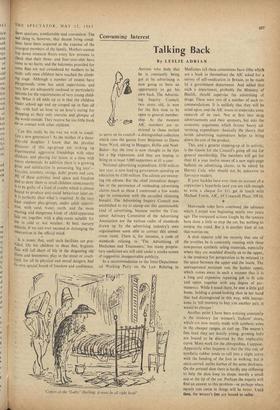Consumint Interest
Talking Back
By LESLIE ADRIAN
National advertising expenditure, £450 million last year, is now lead'ng government spending on education by £100 million. The admen are swamp- ing the edmen. But the chief immediate danger lies in the persistence of misleading advertising claims (such as those I mentioned a few weeks ago in connection with the so-called slimming breads). The Advertising Inquiry Council was established to try to stamp out this questionable kind of advertising, because neither the Con- sumer Advisory Committee of the Advertising Association nor the various codes of standards drawn up by the advertising industry's own organisations seem able to correct this unwel- come trend. There is, for instance, a code of standards relating to 'The Advertising of Medicines and Treatments,' but many proprie- tary medicines are still sold under a smoke screen of suggestive, insupportable publicity.
In a recommendation to the Inter-Departmen- tal Working Party on the Law Relating to
Medicines (all these committees have titles which are a book in themselves) the AIC asked for a survey of self-medication in Britain, to be made by a government department. And added that such a department, probably the Ministry of Health, should supervise the advertising of drugs. These were two of a number of such re- commendations. It is unlikely that they will be acted upon, and the AIC wants to undertake some research of its own. Not at first into drug advertisements and their sponsors, but into the economic arguments which favour heavy ad- vertising expenditure—basically the theory that lavish advertising expenditure helps to bring down the cost of the product.
This, and a general stepping-up of its activity, is the reason for the Council's going all out for general membership. The members will get for their £1 a year twelve issues of a new eight-page bulletin on advertising claims, to be edited by Harvey Cole, who should not be unknown to Spectator readers.
If your hackles have ever risen on account of a copywriter's hyperbole (and you are rich enough to write a cheque for £1), get in touch with Michael Fowle, AIC, 49 Cresswell Place, SW10.
Man-made soles have continued the advance which I noted was beginning nearly two years ago. The rearguard actions fought by the tanners have done a little to stop the rot, but nothing to reverse the trend. But it is.another kind of rot that worries me.
A shoe repairer told me recently that one of the troubles he is constantly meeting with these
non-porous synthetic soling materials, especially where they are moulded directly on to the upper, is the tendency for perspiration to be retained in the space between the upper and the insole. The unevaporated moisture rots the leather upper, which comes away in such a manner that it is a long and expensive repairing job to fit sole and upper together with any degree of per- manency. While I stood there, he sent a little girl home, holding a sound-looking shoe in her hand that had disintegrated in this way, with instruc- tions to 'tell mummy to buy you another pair, it would be cheaper.'
Another point I have been noticing constantly is the tendency for women's 'fashion' shoes, which are now mostly made with synthetic soles in the cheaper ranges, to curl up. The wearer's feet (and they are mostly young, growing feet) are bound to be distorted by this implacable curve. More work for the chiropodists, I suppose. Apparently what happens is that the thin sole of synthetic rubber tends to roll into a slight curve with the bending of the foot in walking. but it .stays curved, unlike leather of the same thickness. On the pointed shoe there is hardly any stiffening to help the shoe keep its shape, merely a small cap at the tip of the toe. Perhaps the experts will find an answer to this problem—or perhaps whets square toes come in things will be better. Until then, the wearer's feet are bound to suffer.






































 Previous page
Previous page